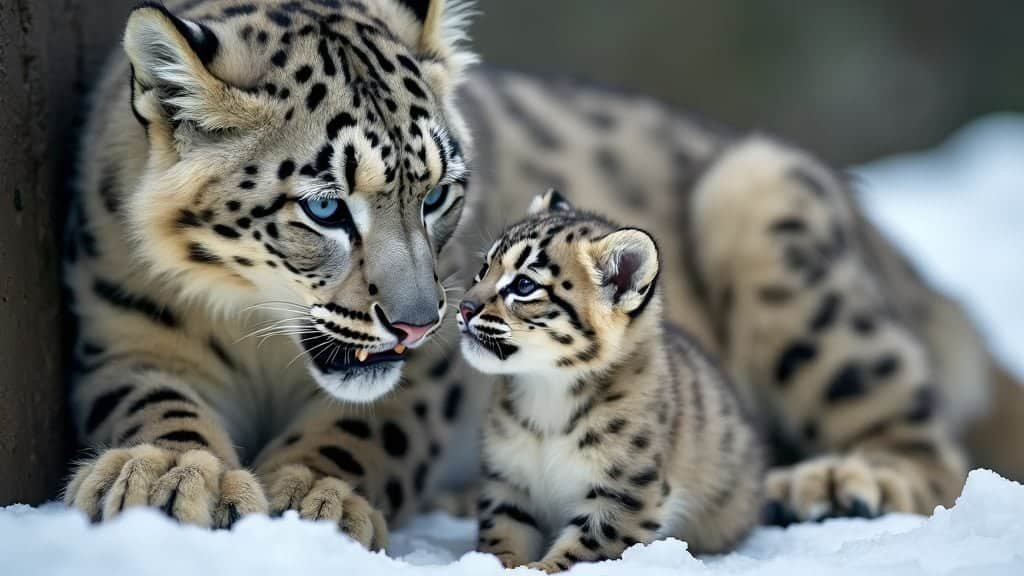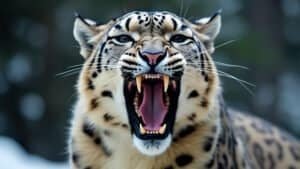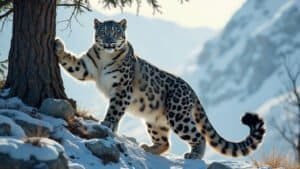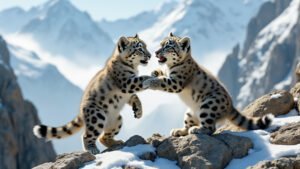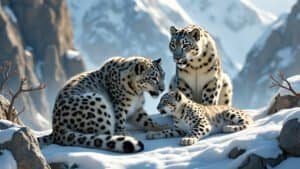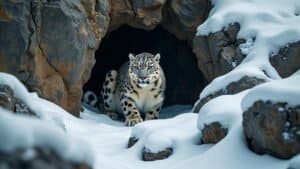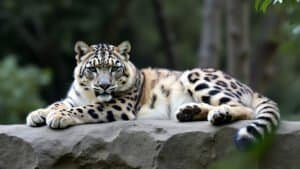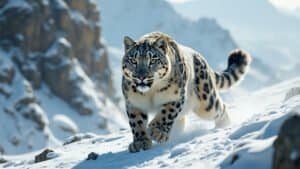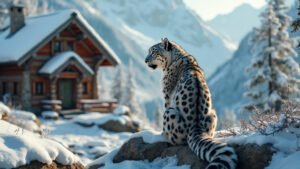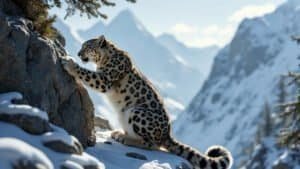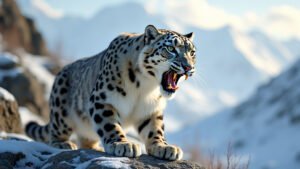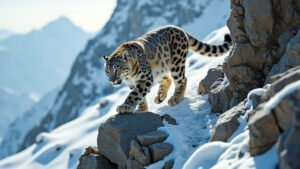Introduction
Snow leopards, elusive and majestic big cats, inhabit the rugged and snowy mountain ranges of Central and South Asia. Raising their cubs in such harsh environments requires remarkable adaptability and care
This article delves into the fascinating process of how snow leopards raise their cubs, from birth to independence. We will explore the reproductive behaviors, nurturing practices, and survival challenges faced by these solitary predators
Additionally, we’ll examine the critical milestones in a cub’s development and the mother’s role in teaching essential survival skills
Snow Leopard Reproduction and Birth
Snow leopards have adapted to the harsh environments of the mountainous regions they inhabit, showcasing unique reproductive behaviors and birthing practices to ensure the survival of their species
Understanding these early stages of life is crucial to appreciating how snow leopards successfully raise their cubs despite numerous challenges
Gestation Period and Litter Size
Snow leopards typically have a gestation period of about 93 to 110 days. This relatively short gestation period is essential for species living in such demanding conditions, ensuring that births coincide with times of relative abundance
A snow leopard’s litter usually consists of 1 to 3 cubs, though there have been instances of litters with up to 5 cubs. However, larger litters are rare due to the difficulties in sustaining multiple offspring in the harsh mountain terrain
Birth Locations and Denning Habits
Snow leopards are highly strategic when it comes to choosing birth locations. They seek out secluded and protected dens, often in rocky crevices, caves, or other sheltered areas that offer safety from predators and harsh weather conditions
These dens are typically located at high altitudes, ranging from 9,800 to 17,000 feet above sea level, providing a secure environment for the cubs’ early development
The mother prepares the den with materials such as fur and dry vegetation to provide warmth and comfort for her newborns
Early Care and Protection
From the moment they are born, snow leopard cubs are entirely dependent on their mother. They are born blind and helpless, weighing around 11 to 20 ounces. The mother snow leopard exhibits intense dedication to her cubs, rarely leaving the den during the initial weeks after birth
She meticulously grooms the cubs to maintain their hygiene and stimulate bodily functions. This early period is crucial for bonding and ensures that the cubs are well-protected from external threats
The mother snow leopard’s protective instincts are vital for the cubs’ survival. She is vigilant against predators such as wolves and eagles, which pose significant threats to the vulnerable cubs
The secluded den locations help in minimizing the risk of predator encounters. Additionally, the mother’s keen senses and agility play a crucial role in deterring potential threats and safeguarding her young
Early Development Milestones
The first few weeks are critical for the cubs’ development. They begin to open their eyes at around 7 to 10 days old, gradually becoming more aware of their surroundings
By the age of two months, the cubs start to explore their den under the watchful eye of their mother, who continues to provide nourishment through nursing. This period is essential for the cubs to gain strength and coordination, preparing them for the more demanding stages of their development
Role of the Mother in Teaching Survival Skills
As the cubs grow, the mother’s role evolves from providing direct care to teaching essential survival skills. By the time the cubs are three to four months old, the mother begins to introduce them to solid food, bringing back small prey to the den
This gradual introduction to hunting is crucial for their survival. The mother demonstrates hunting techniques, from stalking to pouncing, allowing the cubs to observe and practice these skills in a controlled environment
The cubs’ play behavior also serves as an essential component of their learning. Through play, they develop physical abilities and social skills necessary for hunting and surviving in the wild
The mother encourages this play, providing opportunities for the cubs to engage in mock hunts and other activities that mimic real-life scenarios
Weaning and Preparation for Independence
Weaning begins at around two to three months old, but the cubs continue to nurse occasionally until they are about six months old. During this time, the mother gradually increases the proportion of solid food in their diet
The weaning process is a critical transition that prepares the cubs for complete independence. By observing their mother and practicing hunting techniques, the cubs gain the skills and confidence needed to fend for themselves
Nurturing and Feeding Snow Leopard Cubs
Snow leopard mothers exhibit exceptional nurturing behaviors to ensure the survival and development of their cubs. From the moment of birth, the mother’s primary focus is on providing adequate nutrition and teaching essential survival skills
Diet in the Early Months
In the initial weeks of life, snow leopard cubs rely entirely on their mother’s milk for nutrition. This milk is rich in fats and proteins, crucial for the rapid growth and development of the cubs
Nursing typically continues until the cubs are about three months old, although they may still nurse occasionally up to six months old. During this period, the mother rarely leaves the den, ensuring her cubs are fed regularly and remain safe
Weaning Process
Weaning is a gradual process that begins when the cubs are around two to three months old. The mother starts to introduce solid food by bringing small prey items back to the den
These initial prey items are often smaller mammals or birds, which are easier for the cubs to handle and digest. The introduction of solid food is critical, as it helps the cubs transition from a milk-based diet to one that includes the meat they will eventually hunt themselves
Hunting Training
Learning to hunt is one of the most crucial skills a snow leopard cub must acquire. The mother snow leopard plays an essential role in this training process
She begins by bringing live prey to the den, allowing the cubs to practice their hunting techniques in a controlled environment. This hands-on training helps the cubs develop the necessary skills for stalking, pouncing, and killing prey
As the cubs grow older and more proficient, the mother takes them on hunting expeditions. During these outings, the cubs observe and imitate their mother’s actions, gradually becoming more involved in the hunt. This experiential learning is vital, as it enables the cubs to refine their hunting skills and gain the confidence needed to hunt independently
Growth Milestones
The growth and development of snow leopard cubs are marked by several key milestones. By the age of two months, the cubs begin to venture outside the den, exploring their immediate surroundings under their mother’s supervision
This exploration is essential for developing their physical abilities and spatial awareness
At around three to four months old, the cubs start to accompany their mother on short hunting trips. These excursions are not only crucial for their hunting training but also for building endurance and strength
By the time the cubs are six months old, they are actively participating in hunts and are capable of catching small prey on their own
Play and Social Development
Play is a vital aspect of a snow leopard cub’s development. Through play, cubs develop their physical coordination, social skills, and hunting techniques
Activities such as mock hunts, chasing, and wrestling with siblings provide essential practice for real-life scenarios. The mother encourages this play, recognizing its importance in the cubs’ overall development
Social bonds between the mother and her cubs are also reinforced through play. These interactions help establish a sense of security and trust, which is crucial for the cubs’ emotional well-being. The close bond between mother and cubs provides a stable foundation for their development, ensuring they are well-prepared for independent life
Preparation for Independence
The journey to independence is a gradual process for snow leopard cubs. By the age of 18 to 24 months, the cubs are ready to leave their mother and establish their own territories. This transition is marked by increased independence during hunts and a gradual reduction in the time spent with their mother
As the cubs approach independence, the mother becomes less involved in their day-to-day activities, encouraging them to rely on their own skills. This period is critical, as it tests the cubs’ ability to survive and thrive on their own
Successful navigation of this stage is essential for the continuation of the species, as it ensures that the cubs are capable of reproducing and raising their own offspring
Cubs’ Development and Independence
The development and journey toward independence of snow leopard cubs is a fascinating and complex process. It involves a series of growth milestones, skill acquisition, and gradual separation from the mother, ensuring that each cub is well-prepared to survive in the wild
Growth Milestones
Snow leopard cubs experience significant growth and development during their first year of life. Initially, they are born blind and helpless, relying entirely on their mother for nourishment and protection
By the age of two weeks, their eyes begin to open, marking the start of their sensory development. As they reach one month old, the cubs start to become more active, exploring their den and interacting more with their mother and siblings
By two months, snow leopard cubs are ready to venture outside the den. This period of exploration is crucial for their physical development, allowing them to practice walking, running, and climbing
These activities help strengthen their muscles and improve coordination, preparing them for the challenges of hunting and navigating their mountainous habitat
Learning Survival Skills
A critical aspect of a snow leopard cub’s development is learning the skills necessary for survival. The mother plays a vital role in this process, teaching her cubs how to hunt and avoid dangers
Around three to four months old, the cubs begin to accompany their mother on hunting trips. During these excursions, they observe her techniques for stalking and capturing prey
This observational learning is complemented by hands-on practice. The mother often brings back live prey to the den, allowing the cubs to engage in mock hunts
These practice sessions are essential for developing the cubs’ hunting skills, as they learn to use stealth, speed, and precision to catch their food. By the time they are six months old, the cubs are actively participating in hunts, gradually taking on more responsibility
Timeframe for Independence
The path to independence is gradual for snow leopard cubs. Typically, they remain with their mother for about 18 to 24 months. During this time, they continue to hone their hunting skills and learn to navigate their environment
The mother gradually reduces the amount of direct care she provides, encouraging the cubs to become more self-sufficient
By the time the cubs are ready to leave their mother, they have developed the physical and behavioral skills necessary for independent survival. They are capable hunters, adept at navigating the rugged terrain of their mountainous habitat, and possess the knowledge to avoid predators and other dangers
This preparation is crucial, as independent snow leopards must establish their own territories and secure sufficient food to survive
Establishing Independence
The final stage of a snow leopard cub’s journey to independence involves establishing their own territory
This can be a challenging process, as suitable territories are often scarce and fiercely contested by other snow leopards. Young snow leopards must be prepared to defend their new territory from rivals and secure a reliable source of prey
During this period, the cubs rely on the skills and knowledge they have acquired from their mother. Their ability to hunt efficiently and avoid conflict is crucial for their survival. The process of establishing independence is a test of their readiness and adaptability, ensuring that only the most capable individuals contribute to the continuation of the species
Challenges and Survival of Snow Leopard Cubs
Snow leopard cubs face numerous challenges from birth through their journey to independence
These challenges include predation, harsh environmental conditions, and human-related threats. Understanding these obstacles is crucial for appreciating the difficulties snow leopard cubs must overcome to reach adulthood
Predation and Protection
From birth, snow leopard cubs are vulnerable to a range of predators. Natural predators include wolves, eagles, and other large carnivores that inhabit the same mountainous regions. The mother snow leopard’s choice of den site is a primary defense mechanism against these threats. She selects secluded, hard-to-reach areas that provide cover and safety
The mother is also fiercely protective of her cubs, rarely straying far from the den during the early weeks after birth
Her vigilance and readiness to defend her cubs are crucial for their survival. In instances where the den is discovered by a predator, the mother may engage in aggressive defensive behaviors to protect her young, using her strength and agility to fend off potential threats
Environmental Challenges
The harsh environment of the snow leopard’s habitat presents significant challenges for cub survival
Snow leopards inhabit high-altitude regions characterized by rugged terrain, extreme cold, and limited vegetation. These conditions demand a high level of physical resilience and adaptability from both the mother and her cubs
Cubs must quickly learn to navigate the treacherous terrain, developing the strength and agility necessary to traverse rocky outcrops and steep slopes. The cold climate also poses a threat, as hypothermia can be a risk for young cubs
The mother’s dense fur and the insulated den help mitigate this risk, but as the cubs grow and spend more time outside the den, they must rely on their own developing fur and physical conditioning to withstand the cold
Human-Related Threats
Human activities have a profound impact on snow leopard cub survival. Habitat destruction, poaching, and conflict with local herders are significant threats. Snow leopards often come into conflict with humans when they prey on livestock, leading to retaliatory killings by herders seeking to protect their animals
Additionally, habitat fragmentation due to infrastructure development, mining, and other activities reduces the availability of suitable territories for snow leopards. This can lead to increased competition among individuals and higher mortality rates for cubs struggling to establish their own territories
Survival Rates and Conservation Efforts
Survival rates for snow leopard cubs are relatively low, with estimates suggesting that less than half of the cubs born each year survive to adulthood. The combination of predation, environmental challenges, and human-related threats contributes to this high mortality rate
Conservation efforts are crucial for improving the survival prospects of snow leopard cubs. Initiatives focused on protecting and restoring habitats, reducing human-wildlife conflict, and implementing anti-poaching measures are vital
Organizations such as the Snow Leopard Trust and the World Wildlife Fund (WWF) work to engage local communities in conservation efforts, promoting coexistence between snow leopards and humans
Role of Research and Monitoring
Ongoing research and monitoring are essential for understanding and mitigating the challenges faced by snow leopard cubs
Researchers use a variety of methods, including camera traps, GPS collars, and field observations, to gather data on snow leopard behavior, population dynamics, and habitat use. This information is critical for developing effective conservation strategies
Community-based monitoring programs also play a significant role. By involving local people in monitoring efforts, conservation organizations can foster a sense of stewardship and encourage sustainable practices that benefit both snow leopards and human communities
Conclusion
Snow leopards’ ability to raise their cubs in some of the world’s harshest environments is a testament to their resilience and adaptability. From the careful selection of secluded dens for birth to the intricate teaching of hunting skills, snow leopard mothers play a crucial role in their cubs’ survival
Despite numerous challenges such as predation, extreme weather, and human-related threats, the dedicated care provided by the mother ensures that the cubs are well-prepared for independent life. Conservation efforts remain vital in protecting these majestic creatures, allowing them to continue their remarkable life cycle in the wild
